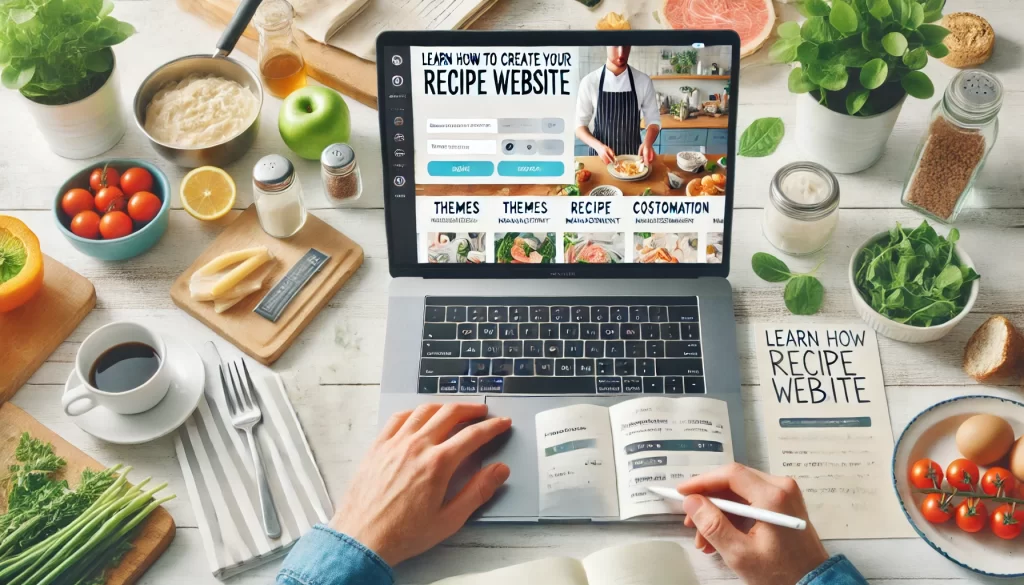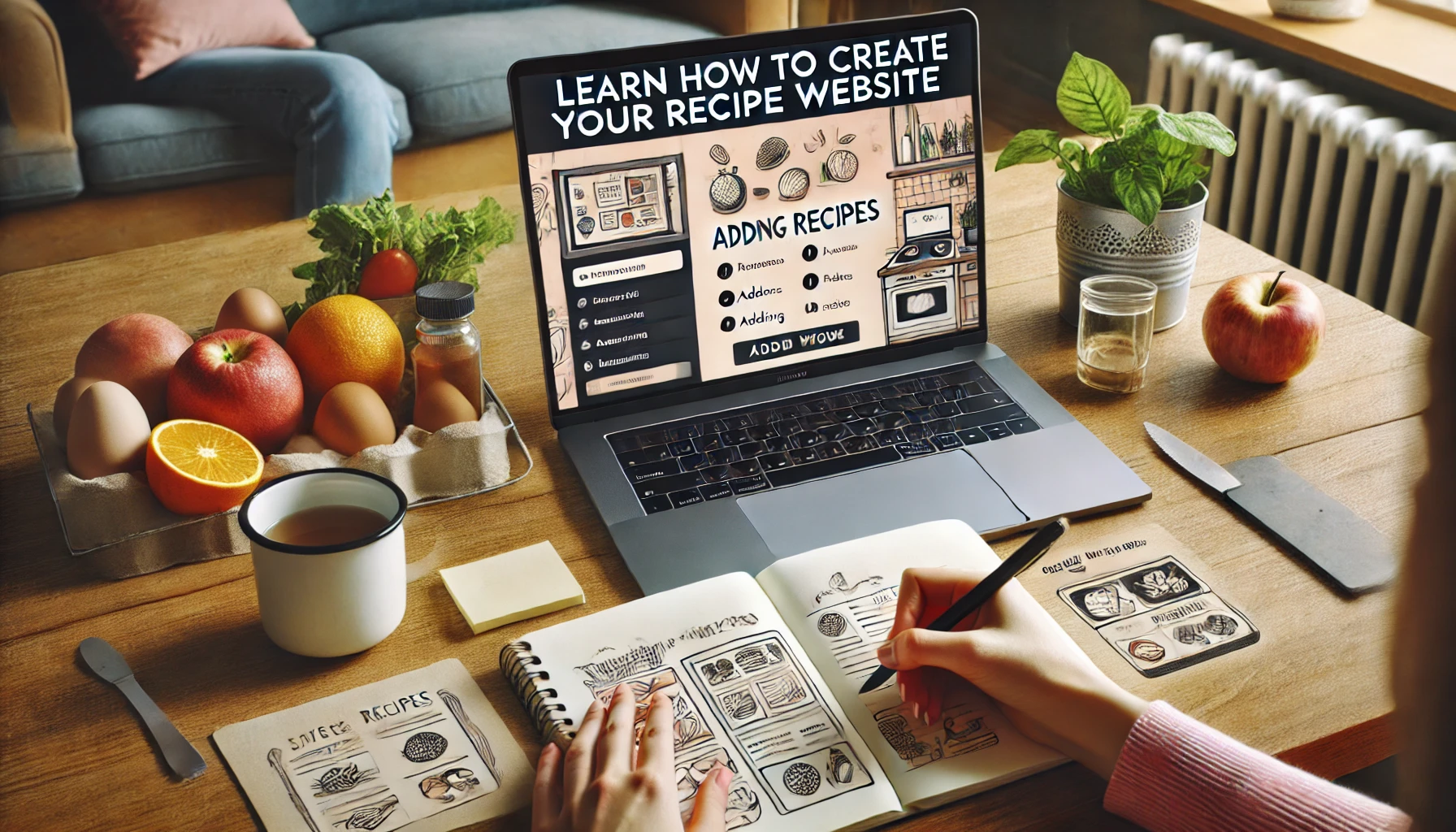Introduction
In the digital age, there’s never been a better time to share your love for cooking with the world. Whether you’re a professional chef, a home cook with a passion for sharing recipes, or simply looking for a creative outlet, creating your own recipe website can be both a rewarding and profitable venture.
Imagine a space where you can post your favorite dishes, organize them in categories, and build a community around your culinary creations. The beauty of creating a recipe website is not just the ability to share your expertise with others, but also the potential to monetize your site through ads, sponsored content, or even paid recipe eBooks. However, starting a recipe website can seem like a daunting task at first. With so many platforms, design choices, and tools to consider, it can be difficult to know where to begin. In this blog, we’ll walk you through the essential steps to building your very own recipe website—from choosing the right platform to optimizing your design and making the website user-friendly.

Steps to Build a Recipe Website
Creating a recipe website requires a blend of technical know-how and creativity. Below are the key steps involved in building your site from the ground up:
Suggested Posts:
• Best Recipe Search Engines to Find Recipes
• Best Free and Paid Recipe Websites to Use in 2025
• Guide to Popular Recipe Websites
Choosing a Platform
When you decide to create your recipe website, one of the first choices you’ll need to make is the platform you’ll use. Popular platforms for recipe websites include WordPress, Wix, and Squarespace, each with its advantages.
- WordPress: Known for its flexibility and customization, WordPress is an excellent choice for those who want full control over their site. It’s open-source and has thousands of plugins designed specifically for recipe management.
- Wix: Ideal for beginners, Wix offers drag-and-drop functionality that makes it easy to create a professional-looking website without the need for technical knowledge. However, it offers less flexibility than WordPress in terms of customization.
- Squarespace: A middle ground between WordPress and Wix, Squarespace offers easy-to-use templates with a sleek design and the ability to add recipe management features.
Ultimately, the platform you choose will depend on your technical skills, budget, and long-term goals for the site. If you plan to grow your website into a business, WordPress may be the best option, but if you’re just starting and want something easy to manage, Wix or Squarespace may be a better fit.
Selecting a Domain Name and Hosting
Once you’ve chosen your platform, it’s time to pick a domain name for your recipe website. Your domain name should be memorable, relevant to your niche (e.g., “SimpleVeggieRecipes.com”), and easy to spell.
- Domain Name: Choose a name that reflects your niche, makes it clear you’re sharing recipes, and has the branding potential.
- Hosting: Your website needs reliable hosting to ensure it runs smoothly. If you’re using WordPress, consider hosting providers like Bluehost or SiteGround, which offer optimized WordPress hosting. Wix and Squarespace, on the other hand, offer all-in-one packages that include hosting.
How to Structure the Website
A well-organized recipe website makes it easier for visitors to navigate and find exactly what they’re looking for. When structuring your site, think about how you can categorize your recipes in a logical way that enhances the user experience.
- Categories: Divide your recipes into categories such as appetizers, main courses, desserts, etc. You might also want to create specialized categories like “30-minute meals” or “Vegan recipes.”
- Recipe Cards: Using recipe cards is a great way to structure individual recipes in a clean, readable format. These cards typically include the recipe’s title, ingredients, instructions, nutritional information, and a photo.
- Search Functionality: Implementing a search bar or filter function can help visitors easily find recipes based on ingredients, meal type, or difficulty.

Recipe Website Design Tips
Design plays a major role in user experience. An attractive and functional website will keep visitors coming back for more. Below are a few tips to make your recipe website visually appealing and easy to navigate:
Suggested Posts:
• How to Create Your Own Recipe Website
• How to Find the Best Recipes on the Web
• Interactive Recipe Websites Design Tips
Make It Mobile-Friendly
More and more people are accessing websites from their phones and tablets. Ensuring that your recipe website is mobile-friendly is crucial for reaching a larger audience. Platforms like WordPress, Wix, and Squarespace offer responsive themes that adjust automatically to different screen sizes.
Use High-Quality Images
Since recipes are all about food, high-quality images are a must. Invest in good photography or learn how to take attractive photos of your dishes. Food styling and natural lighting can make a big difference in how your recipes are presented.
- Before and After Shots: Include both preparation and final dish images to help visitors visualize the process.
- Step-by-Step Photos: Adding step-by-step images or videos can make your recipes even more accessible, especially for beginners.
Easy Navigation
Make sure your visitors can easily browse through your site. A clear, simple navigation bar with links to the main recipe categories and an easy-to-find search bar is essential.
- Dropdown Menus: Use dropdown menus for easy access to categories like vegetarian, gluten-free, or quick meals.
- Call-to-Actions: Include clear call-to-action buttons like “Try This Recipe” or “Save for Later.”
Branding and Consistency
Your website should have a consistent design that reflects your personality or brand. Use a cohesive color palette, fonts, and logo design to create a unique identity for your site.
Tools to Help You Build Your Recipe Website
Many plugins and integrations can make building and managing your recipe website much easier.
Recipe Plugins for WordPress
If you’re using WordPress, there are several plugins designed to help you manage and display recipes effectively. Some popular ones include:
- WP Recipe Maker: This plugin allows you to add customizable recipe cards, with options for displaying ingredients, instructions, and nutrition information.
- Recipe Card Blocks: A plugin that integrates with the WordPress block editor to make adding recipes a breeze.
Social Sharing Tools
To increase engagement and reach, consider integrating social media sharing buttons on each recipe page. This will make it easy for visitors to share your recipes on platforms like Facebook, Instagram, and Pinterest, helping to increase traffic to your site.
- Social Warfare: A popular plugin for easy social media sharing buttons.
- Monarch: A social sharing plugin for WordPress that offers highly customizable buttons.
Email Marketing Tools
Building an email list is an excellent way to engage with your audience. Use email marketing tools like Mailchimp or ConvertKit to send newsletters with new recipes, cooking tips, or exclusive content.
Key Takeaways
Creating your recipe website involves choosing the right platform, selecting a domain, and structuring your site in a user-friendly way. With attention to design, high-quality content, and proper tools, you can create a website that attracts both visitors and potential revenue.
- Choose a platform based on your technical skills and long-term goals.
- Use high-quality images and maintain a user-friendly design.
- Utilize plugins and integrations for recipe management and social sharing.
- Monetize your site through ads, affiliate links, or paid content.
Starting your recipe website is an exciting and rewarding project that allows you to share your culinary expertise with a wide audience. Whether you’re doing it for personal passion or as a business venture, a recipe website is a great way to connect with food lovers everywhere.
By following the steps outlined in this guide, choosing the right platform, structuring your website for optimal user experience, and leveraging useful tools, you’ll be well on your way to building a website that stands out in the competitive world of recipe blogging.
Remember to focus on high-quality content, attractive design, and a user-friendly interface to ensure your recipe website attracts and retains visitors. Happy cooking and website building!
FAQs
What platform is best for creating a recipe website?
WordPress is often the best platform for recipe websites due to its flexibility and availability of recipe-specific plugins. Wix and Squarespace are also great choices for beginners.
Do I need to be a web developer to create a recipe website?
No, you don’t need coding skills to create a recipe website. Platforms like Wix and Squarespace offer drag-and-drop functionality, while WordPress has user-friendly themes and plugins to help you build your site without any coding experience.
How can I make my recipe website stand out?
Focus on high-quality images, clear navigation, and engaging content. Providing step-by-step instructions with photos or videos and offering niche recipes can also help differentiate your site.
Can I monetize my recipe website?
Yes! You can monetize your recipe website through ads, affiliate marketing, selling digital cookbooks, or offering cooking classes.
